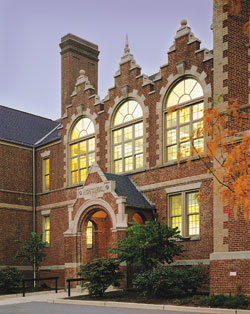Renovating for a Greener, More Accessible Future
Renovation for Sustainability and Adaptability
Examples of these retrofit-ready solutions are widespread, and include new techniques for reducing the solar heat gain coefficient (SHGC) of existing curtain walls and window assemblies, says Erik Sutton, manager of product marketing for EFCO, a Pella Company. Among other fenestration products, manufacturers are introducing lightweight, integral light shelves for curtain wall and storefront systems. The most recent light shelf designs are easier to install than in the past and may offer a tilt-down feature for improved access and cleaning.
According to the Oak Ridge National Laboratories, light shelves also benefit building users by improving the distribution of natural lighting within work and living spaces. Their efficacy, as shown in an ORNL study 1, depends directly on the surface materials used and the light shelf’s geometry and orientation. Passive or fixed light shelves, the study concluded, were found to be equivalent to automated light shelves, in which the angles of the shelf and fins are adjusted according to time of day or solar angle of incidence.
Between-the-glass shades and blinds — a technology that dates to the late 1960s — provide similar benefits of daylight redirection and reduced thermal gain, including enhanced insulation value at night. Protected within a double- or triple-glazed assembly, the daylight control method requires limited maintenance and is easy to operate. Recent improvements to these window assemblies have addressed aesthetics as well as improvements to access of the blinds, thanks to an interior hinged access panel.
| Historic School Renovation Upholds Social Sustainability | ||
A renovation project at the McGinnis School in Perth Amboy, N.J., demonstrates the approach for aluminum-clad wood windows in punched openings. As part of an expansion to increase the middle school’s floor area by one-third, project designers at Philadelphia-based A/E firm Vitetta captured 28,000 square feet of a space within the 100-year-old structure by enclosing an interior courtyard, adding a mezzanine level, turning the auditorium balcony into library space, and converting the basement into a cafeteria by relocating the mechanical systems to the attic.
The firm also focused on restoring its original building’s turn-of-the-century character, according to Steve Carlidge, Vitetta’s principal-in-charge, and the double-hung, fixed windows with fixed transoms incorporate custom muntins for the appearance of historically accurate divided light. The double-hung units — and replacements of the schools original circlehead windows, which had been boarded up for decades — are clad in custom-finished aluminum to match the original tan color. Yet the new windows still allow for blinds between the glass, which can be adjusted to control daylighting, solar heat gain and views to the classrooms. The window treatments required little maintenance, since they are protected. According to Pella’s Zeimetz, “The potential for damage is gone and the blinds just don’t get dirty, two reasons this window choice has become very popular for schools.” The protected blinds and shades are now available for sliding doors up to 4 feet by 8 feet and fixed windows up to 5 feet wide by 6 feet high. Based on the definition of social sustainability, the school project provides better for the physical health of all stakeholders, and provides teachers, students and custodial staff with essential services that relate to window selection. The design by Vitetta also encourages community and greater efficiency through its more cohesive new floor plan. |
Standards and Codes
A number of new standards and codes are also driving the move toward social sustainability. An important example is Pilot Credit 34, “Design for Adaptability,” which is included in the LEED 2012 draft, which is intended to reward designs for future use and modifications. (NOTE: LEED 2012 has not been finalized as of the date of this publication, April 2012.) “Waste from demolition and remodeling accounts for a significant portion of what goes into landfill,” according to LEED user, an online tool published by Brattleboro, Vt.-based BuildingGreen, Inc. “Designing for future use and modifications can reduce the intrusiveness of renovations, significantly reducing the future waste.”
Pilot Credit 34 also aims at homes, as well as mid-rise multifamily construction of the minimum size for meeting FHAA requirements. In order to earn the credit, building designs must do better than code, and have at least twice the number of accessible units. FHAA criteria than what is required by code. Under the LEED point available for Universal Design Features, the project design must meet multifamily criteria for universal design and, in the case of homes, at least one of three design options. Universal design for mid-rise construction must include:
— Zero-step main entrance. Entrances should not have any “abrupt changes in level” and otherwise provide access to all dwelling units and site amenities.
— Accessible doorway. A minimum clear width of 32 inches is given for entry doors when they are open, with room for maneuvering both inside and outside the doorway.
— Accessible passage. There must be an accessible, smooth route of at least 36 inches in width for access to the building areas and living units.
— Adaptable bathroom. Pilot Credit 34 also calls for a minimum area of clear floor space of at least 30 inches by 48 inches, as well as standard shower and toilet fixtures that meet ADA or accessibility criteria.
— Accessible HVAC and lighting controls. For mechanical and electrical systems, positions of the controls, switches and outlets must be free and clear of obstructions and meet accessibility requirements also, located not lower than 15 inches from the floor and not higher than 48 inches.
— Living areas on the accessible level. The accessible level of the living units should include that core dwelling spaces: bedroom, kitchen, dining and living areas and an adaptable full bathroom.
Alternative points under Pilot Credit 34 include “Open Building Structural Systems,” which should allow for flexibility in rearranging rooms, living areas and the entire floor plan without need for significant renovation and material waste. The types of systems that qualify may be “clear-span” structures with partitions or simple, flexible ceiling or floor systems including as open-web floor trusses, raised or plenum floors, and suspended ceilings.
A second option for Pilot Credit 34 can be earned by using “Organized and Accessible MEP Systems,” defined as stacked plumbing risers, mechanical systems and electrical conduit. This technique assumes the typical strategy of stacking rooms that need plumbing or ducts, such as kitchens and baths, with MEP services in common walls and directly above each other from floor to floor. This not only reduces construction costs, it also eases repairs and upgrades; a similar optional credit can be earned by keeping MEP systems separate from within “exterior walls and primary interior structural members.”
Notice

www.us-concrete.com/aridus
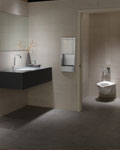
www.totousa.com

www.Nanawall.com
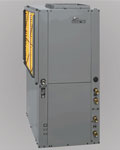
www.climatemaster.com
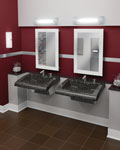
www.bradleycorp.com
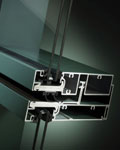
www.efcocorp.com





